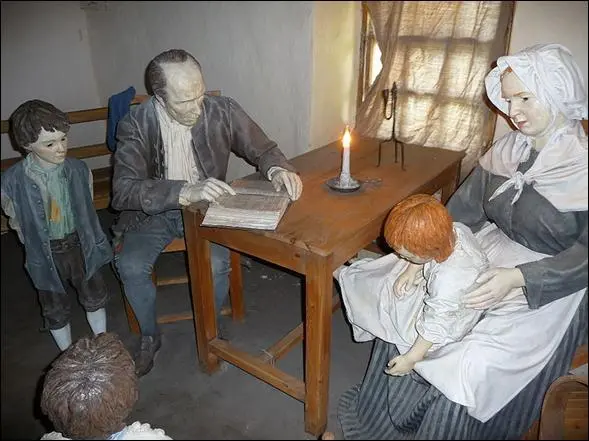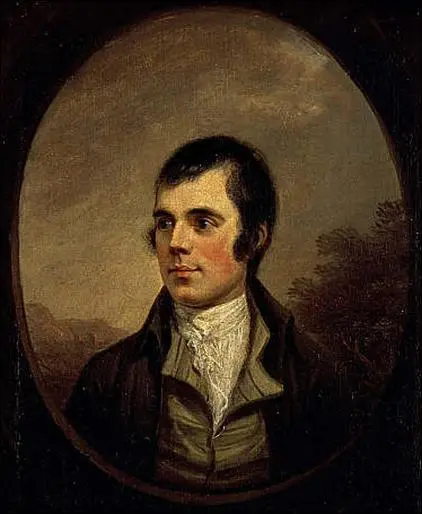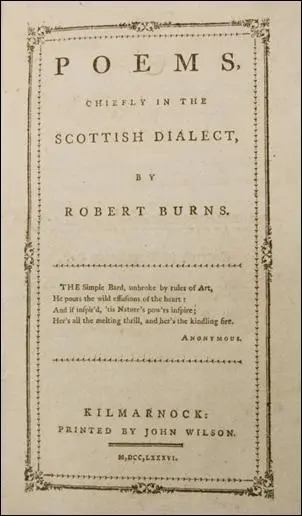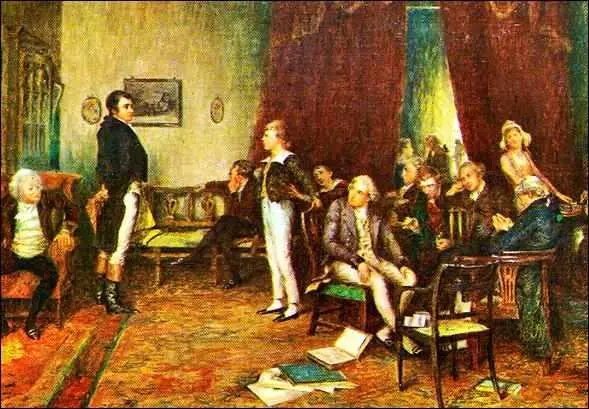It was large, and of a dark cast, and literally glowed when he spoke with feeling or interest. I never saw such another eye in a human head, though I have seen the most distinguished men of my time.”
The new edition of poems brought Burns £400 and won the poet much renown. While staying in the city, Burns embarked on a relationship with the separated Agnes “Nancy” McLehose, with whom he exchanged passionate letters under pseudonyms. When it became clear that Nancy would not be easily seduced into a physical relationship, Burns moved on to Nancy’s domestic servant, who bore him a son, Robert Burns Clow, in 1788. The poet also had an affair with a servant girl called Margaret “May” Cameron. His relationship with Nancy concluded in 1791 with a final meeting in Edinburgh, before she set sail for Jamaica to meet her estranged husband. Before she left, Burns sent her the manuscript of Ae Fond Kiss, one of his most beautiful poems, as a farewell gift.
In Edinburgh, early 1787, Burns met James Johnson, a struggling music engraver and music seller, with a love of old Scots songs and a determination to preserve them. Burns shared this interest and became an enthusiastic contributor to The Scots Musical Museum. The first volume was published in 1787 and included three songs by Burns. He contributed 40 songs to Volume II and he resulted in being responsible for a third of the 600 songs in the whole collection, as well as making a considerable editorial contribution. The final volume was published in 1803.
On his return to Ayrshire in February 1788, Burns resumed his relationship with Jean Armour and took a lease on the farm of Ellisland, near Dumfries, but trained as a Gauger or exciseman, in case farming continued to prove unsuccessful. He was appointed to duties in Customs and Excise in 1789 and eventually gave up the farm in 1791. Meanwhile, in November 1790, he had written Tam O’ Shanter, a supernatural and humorous ballad, which would later become his most famous work.
After giving up his farm he removed to Dumfries. It was at this time he was requested to write lyrics for The Melodies of Scotland and so responded by contributing over 100 songs. He made major contributions to George Thomson’s A Select Collection of Original Scottish Airs for the Voice as well as to James Johnson’s The Scots Musical Museum. These volumes established his reputation and secured his immortal fame, placing him in the front rank of lyric poets.
At this time, Burns’ prospects were better than they had ever been; but he had become bitter at times and had alienated many of his best friends by freely expressing sympathy with the French Revolution and the unpopular advocates of reform in Scotland. As his health began to deteriorate, he began to age prematurely and fell into fits of depression. Some sources alleged that his tendency to drink large amounts of alcohol aggravated his long-standing rheumatic heart condition. In the winter of 1795, Burns died suddenly, following a dental extraction, at the age of 37. The funeral took place on Monday 25 July 1796, on the same day that his son Maxwell was born. He was at first buried in the far corner of St. Michael’s Churchyard in Dumfries, but his body was later moved to its final location in the same cemetery, the Burns Mausoleum, in September 1815. The body of his widow Jean Armour was buried beside him in 1834.
In a comparatively short life, Burns left behind a large corpus of over 550 poems, which have since influenced writers, as well as everyday people, from across the world. As testament to his enduring popularity, Burns suppers are held annually on the poet’s birthday, 25 January, which has become traditionally known as Burns Night. These evenings are commonly celebrated in Scotland, Northern Ireland, Burns Clubs, Scottish Societies and in countless other households worldwide. The first suppers were held in Ayrshire at the end of the 18th century by Robert Burns’ friends on the anniversary of his death, 21 July, and they have been a regular occurrence ever since. Burns suppers usually include haggis, Scotch whisky and the recitation of Burns’ poetry, particularly his apposite Address to a Haggis.
The style of Burns’ poetry is marked by spontaneity, directness and sincerity, ranging from sensitive depth to entertaining humour. Burns’ writings often draw upon a substantial knowledge of Classical, Biblical and English literature, as well as the Scottish Makar tradition. The themes of his poems include republicanism, Radicalism - as revealed in Scots Wha Hae, Scottish patriotism, anticlericalism, class inequalities, gender roles, poverty and sexuality. Serving as a major inspiration of Romantic poets such as William Wordsworth, Samuel Taylor Coleridge and Percy Bysshe Shelley, Burns also popularised the use of Scots dialect in poetry, influencing the works of Allan Ramsay and Robert Fergusson. Now, Burns is regarded as a world poet, his works holding an almost sacred importance for the people of Scotland and an unquestioned respect from all admirer’s of fine literature.

A depiction of the Burns family in the birthplace museum

The famous portrait of Burns by Alexander Nasmyth, 1787

The original title page of the Kilmarnock Edition

The now famous meeting of Robert Burns (left) and a young Sir Walter Scott (centre left), painted by Charles Hardie, 1893

POEMS GROUPED BY YEARS
Juvenile Poems (1773–1779)
1780
1781
1783
1784
1785
1786
1787
1788
1789
1790
1791
1792
1793
1794
1795
Final Poems (1796)
Chronological List of Poems
Alphabetical List of Poems
Juvenile Poems (1773–1779)
1.
1 comment